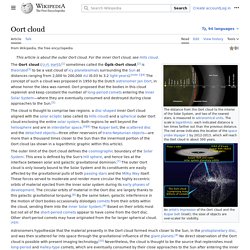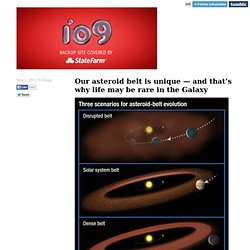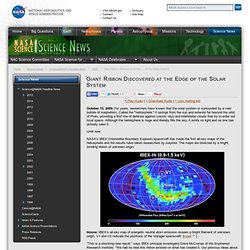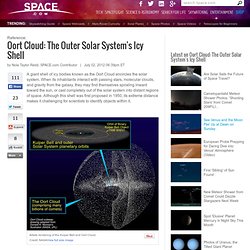

Oort cloud. This graphic shows the distance from the Oort cloud to the rest of the Solar System and two of the nearest stars measured in astronomical units.

The scale is logarithmic, with each specified distance ten times further out than the previous one. Red arrow indicates location of Voyager 1, a space probe that will reach the Oort cloud in about 300 years. The Oort cloud (/ɔːrt, ʊərt/),[1] named after the Dutch astronomer Jan Oort, sometimes called the Öpik–Oort cloud,[2] is a theoretical cloud of predominantly icy planetesimals proposed to surround the Sun at distances ranging from 2,000 to 200,000 AU (0.03 to 3.2 light-years). [note 1][3] It is divided into two regions: a disc-shaped inner Oort cloud (or Hills cloud) and a spherical outer Oort cloud.
Hypothesis. Structure and composition. Origin. Comets.
Stellar perturbations and stellar companion hypothesesEdit. Modified Newtonian dynamics within the Oort cloud. Future exploration. The Oort Cloud: How Big Is Our Solar System? Image Credit: R Mewaldt & P.

Liewer, JPL/NASA Humans generally like stability. We are used to our small, predictable world: Every 24 hours, we rotate on our axis; every 365 days, we revolve around the Sun. We have followed this pattern for millennia, and we will continue to follow this pattern for ages henceforth. For the most part, when we are thinking in cosmic terms, the Earth is steady and unchanging…but the same cannot be said for the rest of the solar system.
Chaos reigns a mere 1.9 light-years from Earth. This portion of our neighborhood is nearly a quarter of the distance to Proxima Centauri, the nearest star to the Sun (which gives you some idea of just how far the Sun’s influence extends). This dark region of space is home to several trillion individual objects larger than 0.62 miles (1 km) and several billion with a diameter over 12 miles (20 km). The objects in this cloud are grouped into two basic groups: short period comets and long period comets. And that’s why life may be rare in the Galaxy. By George Dvorsky Our asteroid belt, which is situated between Jupiter and Mars, has traditionally been seen as something of a nuisance.

Every once in awhile one of these rocks dislodges itself and heads straight for Earth, what often results in a cataclysmic impact. But ironically, as a new study from the University of Colorado suggests, we may owe our very existence to these chunks of displaced rocks. And according to the researchers, our asteroid belt appears to be unique as far as these things go — what may be contributing to the dearth of life in the galaxy. Astronomers and astrobiologists are increasingly coming to see asteroid belts as an important component to solar system composition, planet formation, and the emergence of life. Despite the astronomical chaos produced by impact events, asteroids delivered water, organic compounds, and heavy elements to Earth — what are all crucial for the emerge of life. Image: NASA/ESA/A. Giant Ribbon Discovered at the Edge of the Solar System. + Play Audio | + Download Audio | + Join mailing list October 15, 2009: For years, researchers have known that the solar system is surrounded by a vast bubble of magnetism.

Called the "heliosphere," it springs from the sun and extends far beyond the orbit of Pluto, providing a first line of defense against cosmic rays and interstellar clouds that try to enter our local space. Although the heliosphere is huge and literally fills the sky, it emits no light and no one has actually seen it. Until now. Oort Cloud: The Outer Solar System's Icy Shell. A giant shell of icy bodies known as the Oort Cloud encircles the solar system.

When its inhabitants interact with passing stars, molecular clouds, and gravity from the galaxy, they may find themselves spiraling inward toward the sun, or cast completely out of the solar system into distant regions of space. Although this shell was first proposed in 1950, its extreme distance makes it challenging for scientists to identify objects within it.
Artists rendering of the Kuiper Belt and Oort Cloud.Credit: NASA.